Did you know a few key habits can make a big difference in your work-life success? Highly productive people focus on their Most Important Tasks (MITs), making sure these key tasks are not put off till tomorrow’s to-do list1. If you’re an aspiring entrepreneur or a committed employee, learning and using the best productivity habits can change your daily routines for the better. This can help guide you toward achieving work-life balance. Are you ready to learn from the efficiency experts and change how you work?
Key Takeaways
- Identify and prioritize your Most Important Tasks (MITs) to guarantee crucial accomplishments1.
- Embrace the art of deep work for intense focus and exceptional productivity1.
- Adopt the Eisenhower Matrix to systematically prioritize tasks and focus on what matters12.
- Apply the 80/20 rule to target the efforts that yield the greatest returns12.
- Incorporate break strategies to maintain focus and prevent burnout2.
- Understand that reducing multitasking can dramatically enhance productivity3.
- Establish daily planning habits for a more organized and efficient routine3.
Understanding Productivity: What Sets High Achievers Apart
High achievers stand out because they develop a strong mindset for productivity. They combine healthy habits for productivity with a clear focus on achieving work-life balance. Their effective behaviors and strategies can help anyone wanting to boost their productivity.
A McKinsey report shows high performers are 400% more productive than others4. In jobs like management and software development, their productivity jumps to 800%4. Their success highlights the importance of their workflow habits and the organized settings they create.
🎯 Ready to Transform Your Results?
Get the complete system that hundreds have used to achieve breakthrough results.
Get the Book for $7David Maxfield and Justin Hale’s research points out key habits of high achievers. They’re much less likely to leave projects unfinished or let tasks slip through4. They also rarely have an inbox full of unread emails4. This shows they know how to prioritize and get things done efficiently.
Tim Cook starts his day at 3:45 AM, showcasing the discipline of successful people5. Mark Zuckerberg and Jeff Bezos prioritize exercise. This demonstrates their commitment to keeping fit for better productivity5.
The ‘rule of 52 and 17’ is proven to boost productivity. Taking a 17-minute break after 52 minutes of work is a practice among the most productive workers4. It shows the importance of rest for ongoing productivity.
Productive individuals set clear goals and are resilient. They see failures as chances to learn and grow6. This drive is key to their continuous productivity and helps maintain a balance between professional and personal life.
Moving from procrastination to being productive requires a kind view of oneself. It also needs steady changes in behavior for dealing with life’s twists6. By using these strategies, people can follow in the footsteps of high achievers and greatly improve their productivity.
Learn more about what makes high achievers different by reading this detailed analysis on achieving work-life balance. It offers a deeper look into the dynamics of productivity6.
Establishing Your Daily Priorities: The Path to Achieving Your Goals
Setting effective daily priorities is key to reaching your goals. It fosters growth in both personal and professional life. By managing your time well, setting clear goals, and deciding what tasks are most important, you make every hour valuable.
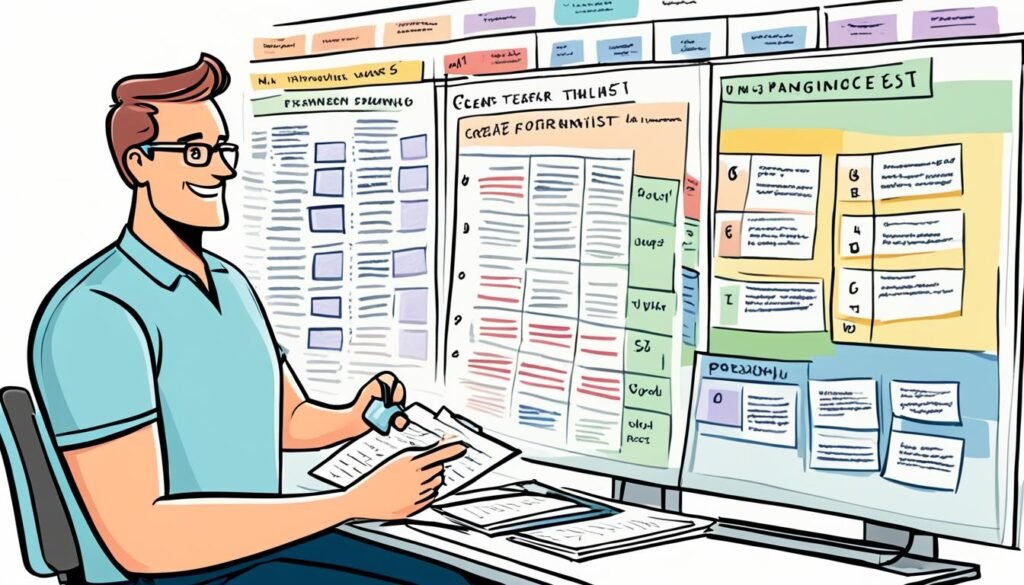
Implementing the Eisenhower Matrix for Effective Time Management
The Eisenhower Matrix helps you sort tasks by urgency and importance. It divides tasks into four groups—urgent and important, important but not urgent, urgent but not important, and neither. This method helps you focus on tasks that push you towards your long-term goals.
A daily planning routine, even just 10-15 minutes, sharpens your focus on productivity7. Studies show that planning for 10 minutes early in the day can save up to two hours of wasted time8.
Setting Clear, Actionable Goals with SMART Criteria
Using SMART criteria—specific, measurable, achievable, relevant, and time-bound—makes your goals clear and reachable within a set period. This clarity is vital for keeping you motivated and accountable.
When handling several goals, aim to focus on up to five major ones for better clarity and focus7. Checking in with your feelings and energy levels every morning helps in setting achievable daily goals8.
Embracing the Most Important Tasks (MITs) Approach
The Most Important Tasks (MITs) approach is about focusing on 1-3 key tasks each day. Give your best hours to these tasks to boost your productivity and keep your projects moving.
Tools like the Eisenhower Matrix and Eat The Frog method help pinpoint these critical tasks. They encourage doing them early for effective focus7. Because these tasks demand mental effort, taking breaks to recharge is crucial8.
Employing specific methods—identifying essential tasks or using a strong goal system—clears the path to your personal and professional achievements. Make solid time management and prioritization your cornerstone habit. This will guide you to success with clear focus and intent.>
Navigating the Deep Work Concept for Heightened Focus
Deep work is crucial for anyone wanting to better their focus and complete major tasks well. Time blocking helps organize your day into focused work sessions.
Cal Newport says deep work means focusing hard for about 90 minutes without any distractions. This boosts your productivity and helps tackle complicated issues better9. Without interruptions, you delve deeper into your work. Getting back on track after being distracted can take up to 23 minutes9.
By following a monastic approach to deep work, you cut out distractions like social media and emails during work. This increases your focus, helps you learn faster, and achieve goals9.
Alternatively, the bimodal method splits your time between intense work and lighter tasks. This way, you can focus fully on important projects for full days, boosting productivity9.
| Strategy | Goal | Benefits |
|---|---|---|
| Monastic Deep Work | Eliminate distractions entirely | Uninterrupted focus, quicker mastery of skills |
| Bimodal Deep Work | Balance deep and shallow tasks | Flexibility and sustained productivity |
| Rhythmic Deep Work | Develop a regular deep work schedule | Consistent output, enhanced work quality |
“A deep work state allows you to move considerably forward in your professional endeavors with less time as opposed to more superficial levels of engagement.”
Deep work boosts focus, keeping you competitive at work. Cutting back on trivial tasks allows for tackling big projects, setting high standards in your field9.
Thus, using time blocking, setting clear goals, and planning deep work sessions are key in this distracting world. With these strategies, your work goes beyond just meeting the basics of your industry.
Developing Best Productivity Habits for Daily Success
To reach your goals and work better, it’s key to adopt great productivity habits. Success comes not just from what we do but also how we handle tasks and distractions efficiently.
Maintaining a Distraction List to Enhance Concentration
Writing down distractions can really help you keep focused. When you note down interruptions as they come, your mind stays clear for current tasks. The University of California, Irvine found that office workers get interrupted every three minutes. And, it usually takes about 23 minutes to get focused again after each disruption10. With a distraction list, you can deal with these breaks in a planned way, instead of letting them immediately derail your flow.
Balancing Workloads with the Pomodoro Technique
The Pomodoro Technique helps you manage your time by breaking it into short work periods with brief rests in between. It boosts focus and stops you from getting too tired, keeping your energy steady through big tasks. James Clear, a well-known productivity expert, says doing things regularly, like the Pomodoro Technique, is key for lasting success11. Because sticking to good habits beats just a one-off effort.
Adopting Time Blocking Techniques for Structured Efficiency
Time blocking means setting specific times for each task, making your day more organized. This way, every hour has a clear goal, from focusing deeply on important projects to taking short breaks. Superhuman’s idea to check emails just a few times a day fits well with this by cutting down on constant interruptions11.
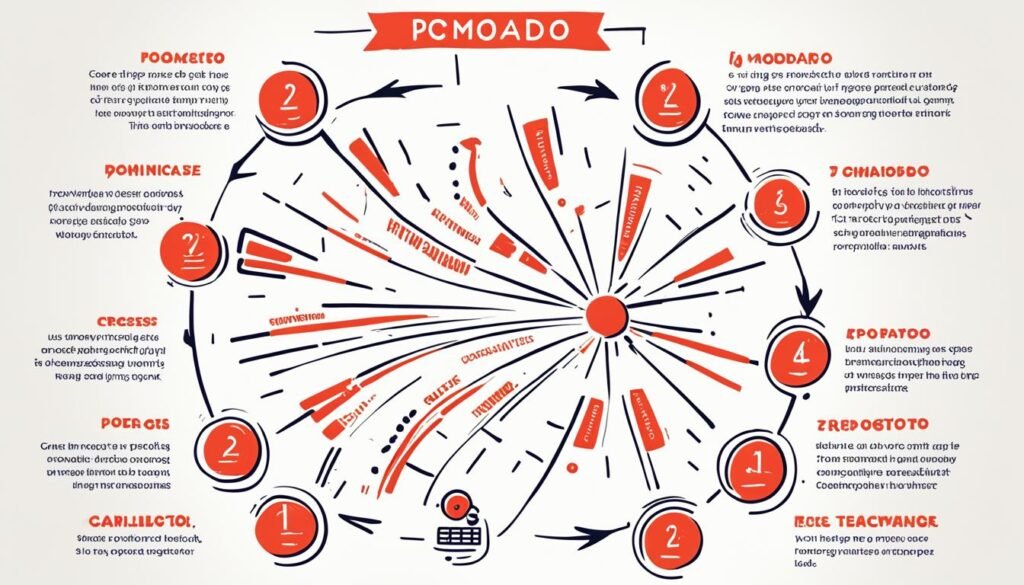
Adding these methods to your routine can really change how you work, making each day a step towards success. By sticking to a distraction list, using the Pomodoro Technique, and time blocking, you become much better at managing productivity.
The 80/20 Rule: Maximizing Impact with Minimal Effort
The 80/20 rule, known as the Pareto Principle, is a game-changer. It proves that 80% of results come from just 20% of efforts. This idea has a big impact in many areas, like improving business and boosting personal productivity1213.
Vilfredo Pareto introduced this rule in the early 1900s. First, he noticed it in how wealth was spread out. Now, it’s key in business strategies and making sure quality is top-notch. Focusing on what really matters can boost results significantly1213.
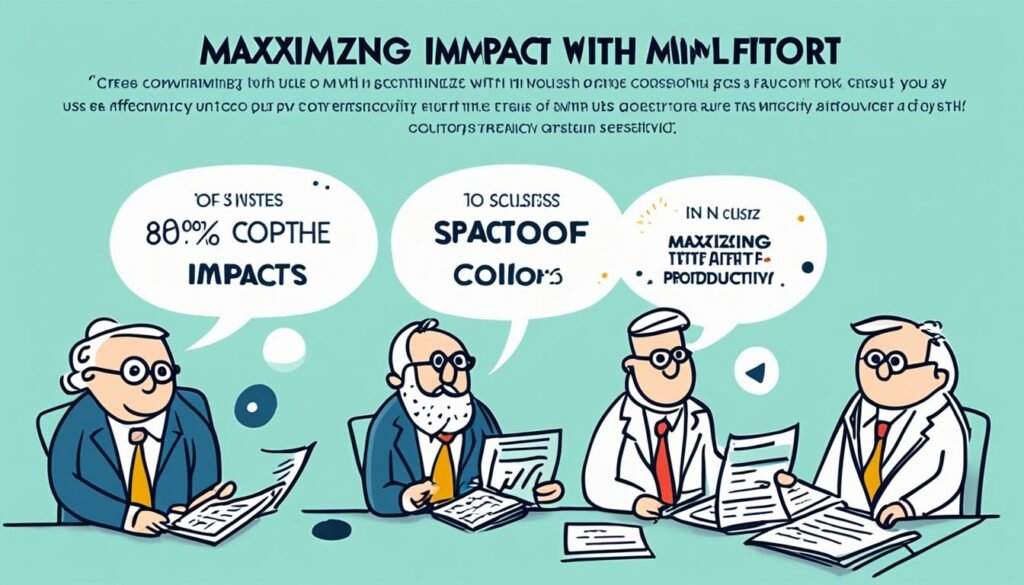
- Target High-Impact Tasks: Focus on doing things that make a big difference. This boosts productivity and success, whether in your career or business1213.
- Quality Over Quantity: The 80/20 rule tells us that a few well-chosen efforts bring most of the results13.
- Strategic Planning: Using this rule for daily and long-term plans makes you more focused and effective in reaching goals14.
Using the 80/20 rule changes how you handle tasks and use resources. By concentrating on the 20% that really counts, you achieve more. You also feel better about your work13. But, don’t forget the rest. Ignoring the other 80% can mean lost chances and risks. So, staying balanced is key12.
If you’re leading a team, running a business, or setting personal goals, the 80/20 rule can up your productivity and success. It’s about being smart in your effort. Make everything you do aim towards your most important goals14.
Cultivating a Mindset for Productivity: Attitude & Mental Preparedness
To boost productivity, start by learning key attitudes that help with efficiency and growth. These include setting up pre-work habits, beating procrastination, and taking on challenges head-on.
A big part of being productive is having a growth mindset, as Carol Dweck explains. This mindset means you keep trying even when things get tough. It helps you not just meet your goals, but surpass them15.
Creating Pre-Work Rituals to Kickstart Your Day
Starting your day with specific rituals can really get you going. Doing things like meditating or planning out your day early can clear your mind and sharpen your thinking. Studies show 82% of workers who have a morning routine feel more efficient at work16.
Overcoming Procrastination through Mindfulness and Accountability
Procrastination is a big hurdle, but you can get past it with mindfulness and accountability. Using mindfulness meditation or a tasks journal can help you stay focused and disciplined. A whopping 91% of people say they’re more productive after cutting down on procrastination with these methods16.
Building a Positive Mental Approach towards Challenging Tasks
Approaching tough tasks with a positive attitude can reduce stress. This optimism helps you not fear failure and stand strong against setbacks15. You can learn how to stay positive and deal with challenges by optimizing your strategies.
Taking breaks and rewarding yourself are also key to managing work well. These practices keep you motivated and on track for a productive lifestyle15.

Embracing these ideas can change your life at work and at home, making you more balanced and productive. By applying these tips, you’ll not only see quick improvements but also lasting changes in your behavior. For more tips, check out this Forbes article on productivity.
Strategies for Prioritizing Tasks and Managing a Hefty Workload
Mastering prioritizing tasks is crucial, especially with lots of work. It starts with choosing the key tasks that give the best results. This mirrors the Pareto principle, suggesting to focus on 20% of work that makes 80% impact17. This way, you improve efficiency and focus on results.
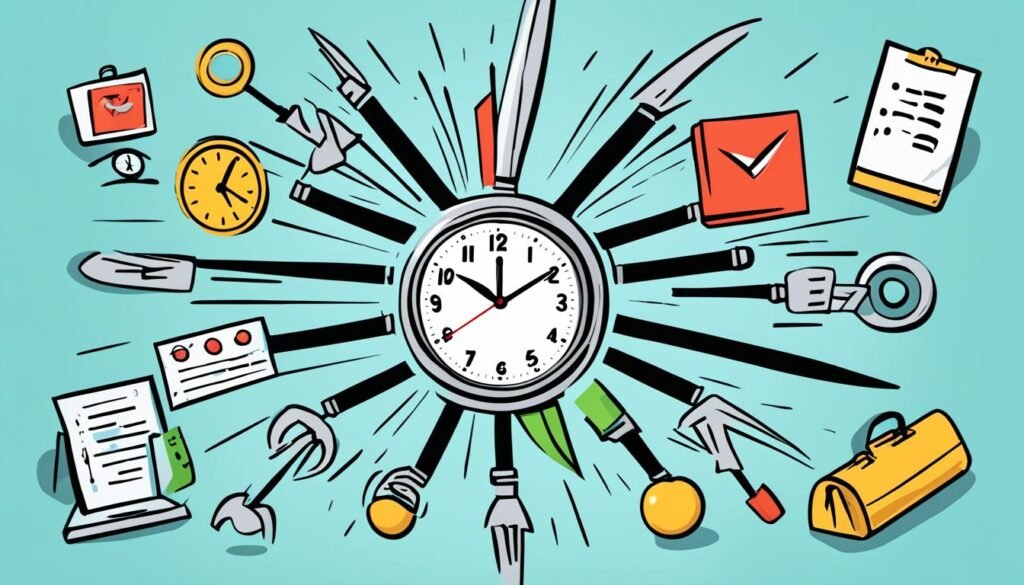
Using tools like ClickUp can change how you handle work. You get to see tasks and deadlines in List View, and Gantt and Timeline views17. These options help track progress and organize time across projects. Being flexible with goal setting strategies is key in fast-changing work environments.
Effective time management means planning and doing tasks based on their importance and urgency. The Covet Matrix puts tasks in urgent-important groups. This makes it easier to see what needs immediate action18. Other ways to manage tasks include:
- Delegating smaller tasks builds team skills and lets you focus on important work19
- Setting SMART goals helps make sure every task matches project goals and deadlines19
- Automating routine tasks frees up time for strategic planning and major projects17
In busy times, with lots of work and deadlines, a systematic approach to choosing tasks is key to improving productivity and keeping a clear mind19. Effective workload management blends using the right tools, applying best practices, and always learning.
Embracing Healthy Habits for Sustained Productivity and Well-being
Adding healthy habits for productivity to your daily life is key for doing well in a busy world. It’s important to mix hard work with regular breaks. This balance, along with managing your energy, can boost your performance and health.
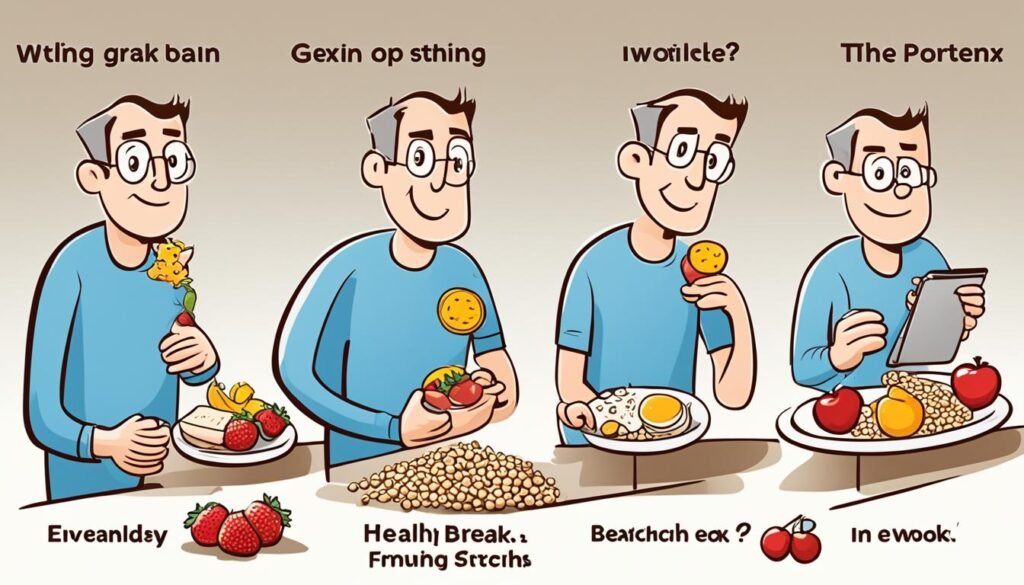
Did you know the average person checks their phone more than 80 times a day? This can really distract you and make it hard to stay focused. Therefore, having set times to relax is very important20.
Importance of Regular Breaks and Physical Activity
Taking short breaks often during work is vital for keeping your mind clear and avoiding burnout. Physical activity not only keeps you fit but also lifts your mood and lowers stress thanks to endorphins. This makes you feel better and work better21.
Trying to do too many things at once, or multitasking, can cut your productivity by up to 40%. This shows the value of focusing on one task at a time and then taking a break20.
Adopting Healthy Eating and Hydration for Energy Management
Eating well helps your immune system and lowers the chance of getting sick, while drinking enough water is crucial for your brain and energy21. Good habits also mean carefully choosing what information you consume and finding time for fun and exercise. This helps you deal with the stress of technology and improves your overall happiness20. Studies have found that companies that support healthy living, like encouraging exercise, good eating, and relaxation, see better focus, higher productivity, and lower healthcare costs among employees22.
Integrating Work-Life Balance: Strategies to Juggle Personal and Professional Life
Achieving work-life balance is key for your health and productivity at work. The rise of remote work has made it harder to separate work from private life. We struggle more to keep professional and personal life apart.
Over 60 percent of U.S. workers feel their work-life balance is off. This number grew when our homes became offices, schools, and places to relax during the pandemic23. Mixing work and personal life under one roof shows why it’s crucial to set clear boundaries.
Analyzing Time Spent and Setting Boundaries
Start by looking at your daily routine to see where work eats into your personal time. The challenges of working from home, like multitasking and distractions, can lead to longer work hours. Set specific work times and let your team know when you are and aren’t available23. This helps protect your private time, avoid burnout, and maintain a better balance24.
Utilizing Technology Wisely to Separate Work from Personal Time
Technology can keep us tied to work, messing up our time management and well-being25. Using tech to do repetitive jobs for us gives more time for personal interests or rest. This not only improves work-life balance but also boosts productivity and wellness24.
Companies that promote a balanced work life see fewer people calling out sick and have happier, more productive employees24. Workers with a good balance are more creative and committed25.
For a real change, you need to set personal limits and need support from your workplace. Simple changes in your daily or weekly routine can make a big difference in improving your life quality23.

Leveraging Technology and Automation to Streamline Your Workflow
In today’s world, using technology is essential to make work easier and improve efficiency. With automation, you can change how you work, giving you time for more important tasks that need your skills.
It’s important to do your homework before picking tech solutions to get better at what you do to learn more about leveraging technology26. Choosing the right tools not only saves money but also puts you ahead of others on leveraging technology to work smarter26. Also, automation tools help keep things consistent and lessen mistakes by using templates and automated steps27.
Tools like Asana or Trello show you what’s happening with your projects, helping you manage tasks better28. By linking these with calendar apps, you keep track of deadlines easier28. Also, chat tools like Slack or Microsoft Teams help your team stay in touch, sharing information quickly and clearly28.

To make the most of technology, it’s vital to keep your team trained and supported26. Watching key performance indicators (KPIs) helps check if the technology is working well26. Also, being ready to tweak and upgrade can improve how things run constantly26.
If you’re unsure about using automation, know that it can take over dull, repetitive tasks. This lets you focus on bigger goals that help your business grow27. Learn more about leveraging automation and see how it makes things simpler and boosts workflow management27.
| Technology | Benefits | Integration Aspect |
|---|---|---|
| Task Management Platforms | Enhances task visualization and management | Sync with calendars for effective deadline management |
| Real-time Communication Tools | Improves team connectivity and information flow | Easily integrates with various productivity apps |
| Automation Tools | Increases accuracy, reduces human error | Templates and workflows streamline complex processes |
By automation and leveraging technology, and always looking for tech integration chances, your business stays flexible, ready to adapt, and leading the way26.
Conclusion
To summarize best productivity habits, we see how steady routines boost our brain power. Research shows that forming good habits is crucial. From eating a healthy breakfast to boost work efficiency, to focusing on one task at a time to avoid productivity loss2930. Think about using strategies like time blocking and productivity apps like Hubstaff. They help organize your day effectively29.
Exercise and taking breaks during work are super important too. Doing things like walking or jogging and taking scheduled breaks can make you up to 15% more productive2930. Using time management methods like the Eisenhower Matrix or the Pomodoro technique is key. They help you figure out what tasks are most important, making your workflow much better2930.
When considering effective productivity strategies, uninterrupted focus is important. Reducing distractions at work helps. It takes about 15 minutes to get focused again after being interrupted31. Using time batching helps handle stress from long to-do lists. It lets you move smoothly through tasks, improving focus, creativity, and productivity31. By following these proven practices, you’re on your way to continuous achievement and well-being. Adding hobbies, getting enough sleep, and using tech like Habitica are part of a balanced life2931.
As you go forward, remember that productivity keeps changing. Always look for ways to improve your habits, cut out what doesn’t work, and try new things. With this knowledge, your efforts will be both effective and fulfilling. By putting these strategies into action, you will see a major change in your work life, making every hour count.
